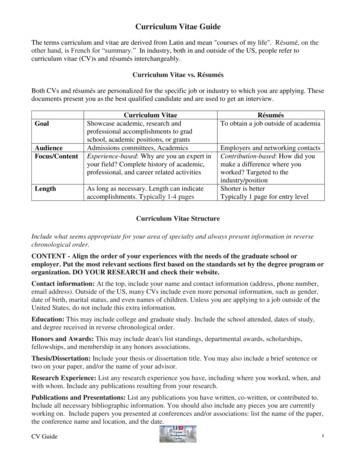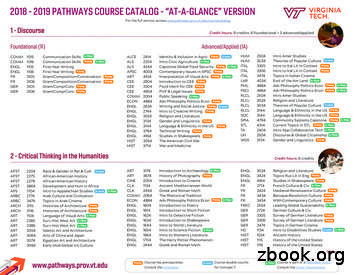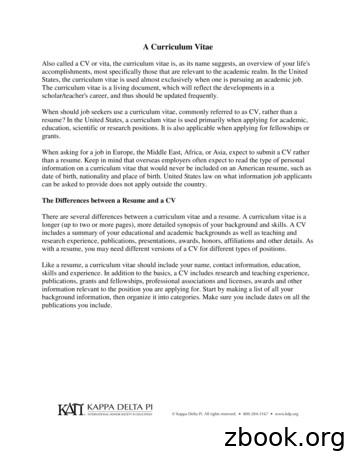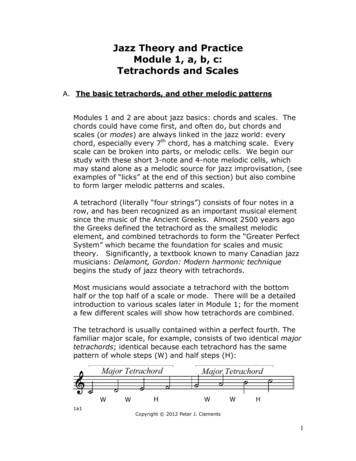Minor Gordon - Curriculum Vitae
Minor GordonCurriculum orgcv256@minorgordon.netTroy, NY 12180SummaryI am a computer scientist, technical lead, software architect, thinker-doer, lifelong learner, avid reader, and U.S. citizen.01/2021 –ResponsibilitiesProjects01/2021 –01/2021 –01/2021 –ExperienceSenior semantic solutions architect at TopQuadrant, Inc. / RemoteTopQuadrant is the developer of TopBraid EDG, a data governance platform based on W3C standardtechnologies such as RDF, SPARQL, and SHACL. TopBraid EDG facilitates access to enterprise metadata,business terms, reference data, data and application catalogs, and data lineage. The company‘s customer listincludes organizations in financial services, pharma, healthcare, digital media, government, and other sectors.Technical leadership: mentoring colleagues, disseminating knowledge, reviewing code, trying newtechnologies and piloting new approaches to professional services tasksPre-sales: gathering requirements from initial prospect meetings in order to tailor demosProfessional services: advising customers, developing bespoke product extensions, system integrationConfidential professional services projectsTechnologies: Scala, Java, Python, Haskell, TypeScript, React.js, RDF, GraphQL, Docker, GitHub Actions, AWSEDG application frameworkDesigned, implemented, and documented a new framework for creating TopBraid EDG extensions in anylanguage by developing auxiliary web applications and deploying them as Docker containers. Having moretool options (languages, libraries) improved the Professional Services team’s productivity in implementing oneoff extensions and integrations for customers.EDG clientDeveloped and documented client code libraries in Java and Python and a Java/Scala/Python client codegeneration harness for multiple TopBraid EDG server APIs (REST, GraphQL). These superseded ad hoc APIclient code in Professional Services projects and streamlined the implementation of new projects.06/2019 – 01/2021 Technical lead at Rensselaer Polytechnic Institute (RPI) / Troy, NYThe Tetherless World Constellation (TWC) at RPI is a constellation of multidisciplinary researchers who studythe scientific and engineering principles that underlie the Web. I served as the Director of Semantic WebApplications under Professors Deborah McGuinness and James Hendler, who were the Principal Investigatorson multiple sponsored research projects involving ontologies, symbolic reasoning with OWL, and provenanceaware data systems.Responsibilities Technical leadership: mentoring junior staff and students, code reviews, process development, guest lecturesSubject matter expertise: advising staff and students on software engineering best practices and toolsRecruiting: reviewing resumes, coordinating, interviewing for student and staff positionsSoftware development: design and implementation of technically challenging work streamsProjects01/2020 – 01/2021 DARPA Knowledge-directed Artificial intelligence Reasoning Over Schemas (KAIROS) programCollaborated with IBM Research to develop a web-based schema curation tool using Play framework MVCwith Sangria GraphQL in Scala and a TypeScript React.js front end. The team used the tool to browse, search,and visualize the outputs of natural language processing pipelines in order to improve the quality of the team’sDARPA evaluation submissions.01/2020 – 01/2021 DARPA Machine Common Sense (MCS) programBootstrapped a framework and led a team of students and staff building a common sense knowledge graph byextracting, transforming, and loading diverse structured and semi-structured data sources.
Led a team of students and staff developing a web-based portal for exploring common sense knowledgegraphs, common sense question-answering processes, and benchmarks for those processes.01/2020 – 01/2021 Open source user interface framework for semantic applicationsDesigned and bootstrapped a framework for students to build user-facing semantic applications for multiplesponsored research projects. The framework incorporated: Play framework MVC with Sangria GraphQL inScala; a library of Scala type classes and associated helpers, published to Maven Central, for serializing anddeserializing RDF to and from case class domain models; a TypeScript React.js base library, published tonpmjs; Docker deployment; and Continuous Integration with CircleCI.09/2019 – 01/2021 Open source provenance-aware knowledge storeDesigned and implemented a new provenance-aware knowledge store in Java for use in multiple sponsoredresearch projects. Implementation work included: a REST API for manipulating the store and Java and Pythonclients for the API, a SPARQL 1.1 endpoint, a public-facing Java library API, Docker images on Dockerhub, Javaartifacts on Maven Central, documentation on readthedocs.io, and Continuous Integration with CircleCI.06/2019 – 01/2021 IBM Health Empowerment by Analytics, Learning, and Semantics (HEALS) projectAdvised students in software engineering best practices such as GitHub workflows, code reviews, and testdriven developmentSupervised a student in the construction of a domain-specific language for expressing health care guidelinesand translating them to a machine-reasonable form (OWL), using Java and ANTLR4Parallelized and optimized the construction of a large food-related knowledge graph, reducing build timesfrom 10 hours to less than 1 hour06/2019 – 9/2020 AFRL Explainable artificial intelligence for Dynamic Spectrum Allocation programEngineered Continuous Integration pipelines and Dockerized a legacy code baseDesigned and prototyped a domain-specific language in Scala for representing wireless spectrum accesspolicies as well as requests for spectrum access, then mentored a student in further implementationSupervised students in the implementation of novel domain-specific visualizations, such as a web applicationbased on the Kepler.gl geospatial analysis toolExtracted, transformed, and loaded public and proprietary domain data sources to support web-based demos04/2018 – 04/2019 Technical lead at Asemio, LLC / Tulsa, OKAsemio is a technology consulting company for community data systems. The company works withorganizations that are solving complex problems in the criminal justice, education, health, and social sectors.Responsibilities Project planning: user story mapping, release design, technical architecture, time estimationSubject matter expertise: responding to RFPs and other internal and external needs for technical expertiseTechnical leadership: mentoring junior developers, code reviews, process development, flower arrangingRecruiting: outreach, reviewing resumes, coordinating, interviewingSoftware development: design and implementation of strategic projectsProjects04/2018 – 04/2019 Privacy-preserving record linkerDesigned and prototyped a privacy-preserving record linker to support care coordination between socialservices by determining entity overlap between HIPAA and FERPA protected data sets. The implementationused the Sharemind platform for secure multi-party computation, Python libraries and scripts, and C . Thesuccess of the prototype paved the way for the company’s flagship product.Wrote a white paper describing the privacy-preserving record linking process and comparing its results toplaintext record linking with deterministic and probabilistic algorithmsDrafted and was awarded a 25,000 grant from a national foundation to fund this work08/2018– 04/2019 Community asset mapping platformDesigned and implemented a dashboard web application for tracking community assets such as serviceorganizations, funders, collaboratives, data sharing platforms, et al. The web application was developed withTypeScript React.js, Python Flask, and a neo4j graph database.07/2012 – 03/2018 Freelancer / part-time projects at MG4 Consulting, LLC (self-employed) / RemoteProjects05/2019 – 6/2019 Data entry web application for PSW Applied Research Inc. / Toronto, ONBootstrapped a data entry application using Flask, rdflib, SPARQL, and Virtuoso on the backend, TypeScript,React.js, and GraphQL on the frontend, Cypress end-to-end testing, and Docker deployments to multipleenvironmentsDocumented and handed off the code to a junior developer
06/2017 – 03/2018 Motivated Cognition experiment for Columbia University / New York, NYMotivated Cognition is a web-based research experiment investigating the effects of cognitive bias on ourconsumption of information online.Collaborated with a graduate psychology researcher in order to create a complete web application from highlevel requirements, using TypeScript, Knockout.js, and webpack on the frontend; Java with microservices,YAML configuration, and MongoDB persistence on the backend; generated code for models and services inTypeScript and Java; Jenkins continuous integration; and Docker deploymentTranslated screens from a graphic designer into pixel-perfect CSS and HTMLIntegrated the web application with Mechanical Turk for subject recruitment04/2017 – 05/2017 Drug name comparison project for PSW Applied Research Inc. / Toronto, ONImplemented Kondrak‘s phonetic alignment and similarity algorithm (ALINE) and a bigram-basedorthographic algorithm (BI-SIM) as a PostgreSQL C extension. The system flags similar-sounding names inorder to reduce drug name confusion, a common cause of medication errors.Built a JavaScript demo application using jQuery and Bootstrap04/2016 – 03/2018 Full-stack development for Polygon Analytics Ltd. / Edinburgh, ScotlandDesigned and implemented proprietary software in C and Python09/2014 – 03/2018 Notablist email newsletter search engine for Notablist, Inc. / New York, NYNotablist indexes millions of email newsletters in order to provide insight into the technology use and sendingpractices of hundreds of thousands of email senders. Notablist is used by sales teams in the email marketingindustry for lead generation and lead qualification.Backend prototyping in Python: Classified signup responses and mapped form inputs using numpy/scipy/scikit-learnBackend production rewrite in Java: Generated Python JSON-RPC clients, Python command line tools, Java service interfaces and abstractimplementations, and Java JSON-RPC servlets from Thrift interface and data structure definitions Implemented Guice-injected Java micro-services that encapsulated MongoDB collections; ElasticSearchindices; Redis databases; S3 buckets; screenshotting and signups with Selenium; SpamAssassin checking;logstash queries; Stripe integration; Drip (CRM) integration; MailChimp, SparkPost, and SendGridtransactional email posting; etcd locking; DNS and whois querying and parsing; DMOZ category and Alexaand Quantcast rank lookups Designed and implemented a scalable distributed system for processing Common Crawl WARC records andsubmitting newsletter signups Reported metrics to InfluxDB Created administrative user interface in Vaadin Set up Jenkins continuous integration Deployed with Docker Kubernetes on real hardwareFrontend: Assumed responsibility for a three year-old Bootstrap Backbone.js Marionette.js code base in JavaScript Incrementally migrated code to TypeScript with Knockout.js Added Selenium (Java) browser tests04/2014 – 07/2014 Muninn Project transcription crowdsourcing for PSW Applied Research Inc. / Toronto, ONCreated a command-line Java application for transcribing handwritten World War I medical records from theCanadian Expeditionary Force (http://blog.muninn-project.org/node/79) using Amazon's Mechanical Turkcrowdsourcing service: precut images for groups of lines, redundancy between workers, artificially-introducedmistakes and edit distances to detect cheating, and feedback to workers. The results were published as LinkedOpen Data on the Canada Open Data Portal.07/2012 – 03/2018 TeraScript product suite for Tronics Software, LLC / El Dorado, CATeraScribe and TeraScript Server are a visual development environment and server-based runtime forTeraScript Action Files (TAFs), TeraScript Class Files (TCFs), and the TeraScript Markup Language (TML). TMLis a markup-based web application language, similar in spirit to ColdFusion. TAF and TCF are ways oforganizing TML.TeraScript Server 8:Rewrote TeraScript 7 in Java while maintaining strict backwards compatibility: Grammar-based compilers for TML and associated little languages using ANTLR Tree interpreters for TML, TAF, and TCF Versioned OSGi bundles with Maven and Apache Felix Library of standard functions, primitive types, and collections with extensive unit tests
TeraScript Server 7 (formerly Witango Server):Reorganized, cleaned up, and modernized a 17-year-old C code base and addressed numerous bugs andfeature requests for the server's first major release in over two years; now in maintenance releasesEliminated diverging platform-specific build systems (on Win32, Linux, and OS X) in favor of CMake andported the code base to Win64 using Visual C 2012Designed and implemented a SQL generator that visits dialect-specific trees of SQL-99 constructsTeraScribe 8:Reorganized and cleaned up a 10-year-old Java Swing code base in order to add a number of features to thecode editor, including autocomplete and syntax highlighting, and refit the data source management interface touse JDBC metadataSubcontracting:Debugged production installations of TeraScript Server 7 and 8Developed cross-platform (Android, iOS, Windows) mobile app prototype with Xamarin Forms and C#12/2011 – 06/2012 Co-founder at Grokio, LLC / New York, NYProjectBusiness intelligence platformDesigned an agent (Python) and manager (Java with Spring Security MVC and Guice) architecture forgathering, storing, and querying time series data and metadataImplemented time series databases from scratch using relational tables and memory-mapped filesWrote RFC 3986 grammar-based URL and URN parsers using Ragel (Java) and pyparsing (Python)Generated service interfaces in Java and Python with custom Protocol Buffers compiler pluginsCoded agent plugins in Java and Python for discovering and fetching metric metadata and data: Open source monitoring systems: Nagios, Ganglia, collectl, Graphite Open source server software: Apache httpd, nginx, MySQL, memcached, MongoDB, JMX Platform interfaces: procfs, sysctl, WMI, SNMP Third party APIs: Google Analytics, MailChimp, Spring Social, Amazon CloudWatchSupervised user experience and graphic designers in UkraineImplemented a client-side user interface with the Google Web Toolkit, starting from wireframes: Architectural best practices: Model-View-Presenter; event bus; activities and places Custom widgets: date time range picker, cell table pager, search box, selection tree .war deployment to Tomcat with Maven08/2011 – 12/2011 Back-end software engineer at Birchbox Inc. / New York, NYProjectWarehouse integrationDesigned, implemented, documented, and successfully deployed Java (backend) and PHP (administrativefrontend) code to integrate the Magento e-commerce platform with a third party warehouse API. The codeprocessed millions of dollars of orders over a period of years.Produced ad hoc business reports for other teams from MySQL using Java and Jython05/2011 – 08/2011 Performance analyst at Chartbeat Inc. / New York, NYProjectBenchmarking server stacks in order to provision EC2 instancesSynthesized a realistic benchmark for front-line web servers from statistical analyses of nginx access logsSignificantly reduced network bandwidth and latency on production servers with targeted optimizationsWrote Python scripts for analyzing Ganglia RRDs, replaying HTTP request streams, harnessing httperfs10/2010 – 04/2011 Contract software engineer at IBM Research / Hawthorne, NYProjectFile I/O library for X10, a type-safe, parallel object-oriented language for high-productivity computing.Designed, implemented, tested, and documented a new low-overhead, buffer-based file library for X10: inspired by POSIX, FUSE, Boost.Filesystem, and Java NIO.2 X10 and native code for the Java and C source-to-source compilation backends Scatter/gather I/O, aligned buffers, memory-mapped files, advisory lockingMicrobenchmarked the X10 runtime01/2009 – 07/2010 Programmer/analyst at NEC High Performance Computing Europe GmbH / Stuttgart, GermanyProjects01/2009 – 07/2010 LXFS: fast and reliable data storage for computing clusters
Wrote Python and bash scripts for configuring, deploying, and administrating LXFS installations: Lustre andlnet configuration (MGS, MDS, OSS, clients); redundant NFS exports; Nagios, Ganglia, and collectl monitoring;Heartbeat/Linux-HA services for failover; Promise RAID devices; network interfaces (Infiniband, bondedEthernet)Finished two major LXFS releases, used in numerous deploymentsDebugged and resolved issues in production parallel file systems01/2009 – 07/2010 XtreemFS: a distributed and replicated file system for WANsDesigned, implemented, and tested the XtreemFS userspace client: FUSE and Dokan (Windows FUSE-like library) interfaces Multiple pipelined ONC-RPC streams to a a single server Staged, event-driven concurrency for robust performance under load Close-to-open file caching with per-file page sizes Automatic failover between file replicas on timeout Heavily benchmarked under different I/O loads (iobench, dbench, metadata benchmarks)Finished two major XtreemFS releases, both used in productionCollaborated with academic and industry partners in Europe, Israel, and China12/2019 –11/2015 –07/2016 –Personal Open Source ProjectsParadicms: ETL framework and static site generator for cultural heritage collectionsTechnologies: Python, TypeScript, React.js Next.js, Cypress, AWSDressDiscover: suite of web applications for digital costume collectionsTechnologies: Python, TypeScript, React.js, spaCy, AWSPastpy: Python library for reading PastPerfect (museum database) exportsTechnologies: dingProjectPh.D., Computer Science, University of CambridgeJean BaconSteven Hand, University of Cambridge; James Larus, Microsoft ResearchStage scheduling for CPU-intensive serversEPSRC grant for the EDSAC 21 projectYield: a high-performance C application serverYield was the vehicle for both my Diplom and Ph.D. research. Its features included: Staged, event-driven concurrency Non-blocking socket I/O (TCP, SSL, UDP) with efficient polling (epoll, kqueue, event ports) Asynchronous file I/O (POSIX AIO, Linux libaio, Windows I/O completion ports) File system event notification (inotify, kqueue, OS X volume monitoring, ReadDirectoryChangesW) Atomic reference-counted objects (similar to the Boost/TR1 shared ptr) with efficient use conventions Optimized hash tables: cuckoo hash tables, HAT tries, string array hash tables Non-blocking data structures: queues, stacks, circular buffers HTTP request and response parsing with Ragel state machines based on the ABNF in RFCs 822 and 2616 URI parsing with a Ragel state machine based on the ABNF in RFC 3986 HTTP clients and servers with support for pipelining and chunked encoding ONC-RPC, XML-RPC, and JSON-RPC clients and servers with efficient parsing and serialization Efficient SOAP parser (libxml2, SAX with DOM fallback) and serializer, SOAP clients and servers Object marshalling: XDR, XML (libxml2, genx), JSON (yajl) Embedded script interpreters and gateways: Python, PHP, Lua, Prolog, CGI, FastCGI, SCGI Minimalist xUnit-like unit testing framework (yunit) with one set of unit tests per classServers implemented: HTTP static file servers, benchmarked with httperf generating a SPECweb99-like workload Back end image processing pipelines (decode JPEG, scale, crop, blur, encode JPEG), benchmarked with acustom client and real application traces English Wikipedia page lookup and keyword search engine using Berkeley DB and various NLP libraries,benchmarked with httperf with URI logs synthesized from Wikipedia page statistics
Yield's concurrency architecture is based on the concept of stages for parallelizing CPU-intensive code(gzipping, parsing, serialization) and offloading blocking calls (disk I/O, DNS lookups). A stage is a unit ofconcurrency: two stages can always run on two different physical processors with minimal Diplom Informatiker, Technische Universität BerlinAlexander Reinefeld, Hans-Ulrich HeißStaged design for highly concurrent web serversPrecursor to Yield (see above)2003SupervisorResearch focusFundingProjectB.Sc., Computer Science, Oklahoma State University TulsaMarcin Paprzyckisoftware agents, Semantic Web technologiesfull academic scholarship from the State of OklahomaE-Travel Support SystemA software agent-based content personalization system designed to support travelers using handheld devicesand desktop tformsSkillsEnglish (native); German (fluent)Scala; Java; Python; TypeScript; C ; C#React.js; Knockout.js; Next.js; Thrift; Protobufs; FlaskPostgreSQL; neo4j; ElasticSearch; MongoDB; RedisWindows; Debian- and RedHat-based Linux; OS XTeaching02/2014 – 04/2014 SQL Fundamentals and Python Fundamentals workshops for Ph.D. students and post-doctoral researchers inthe natural sciences at Iowa State University / Ames, IA01/2002 – 03/2002 Mathematics tutoring for 6th and 7th graders at Tulsa Public Schools / Tulsa, OKSelected PublicationsShirai, S., Seneviratne, O., Gordon, M., Chen, C., McGuinness, D. (2021 January). Identifying Ingredient Substitutions Using aKnowledge Graph of Food. In Frontiers in Artificial Intelligence: AI in Food, Agriculture and Water.Santos, H., Mulvehill, A., Erickson, J. S., McCusker, J. P., Gordon, M., Xie, O., . & Berlinsky, A. (2020, November). A SemanticFramework for Enabling Radio Spectrum Policy Management and Evaluation. In International Semantic Web Conference (pp. 482498). Springer, Cham.Gordon, M. (2010). Stage scheduling for CPU-intensive servers (No. UCAM-CL-TR-781). University of Cambridge, ComputerLaboratory.Gordon, M. (2007). Twisted in knots [a review of Twisted Network Programming Essentials by Abe Fettig]. IEEE Distributed SystemsOnline, (3), 5.Gordon, M. (2006). Small-scale peer-to-peer overlays. ACM SIGOPS Operating Systems Review, 40(3), 45-48.Hupfeld, F., & Gordon, M. (2006, November). Using distributed consistent branching for efficient reconciliation of mobileworkspaces. In 2006 International Conference on Collaborative Computing: Networking, Applications and Worksharing (pp. 1-9).IEEE.Gordon, M. (2005). An introduction to network programming the Python way [a review of Foundations of Python NetworkProgramming by John Goerzen]. IEEE Distributed Systems Online, 6(10).Gordon, M. (2004). A Textbook for the Semantic Web [a review of Knowledge Representation by John Sowa]. IEEE DistributedSystems Online, (1), 6.Gordon, M. (2004). An introduction to RDF technologies: Too little, too soon [a review of Practical RDF by Shelley Powers]. IEEEDistributed Systems Online, (8), 5.Paprzycki, M., Gilbert, A., & Gordon, M. (2002, October). Knowledge representation in the agent-based travel support system. InInternational Conference on Advances in Information Systems (pp. 232-241). Springer, Berlin, Heidelberg.
06/2019 – 01/2021 Technical lead at Rensselaer Polytechnic Institute (RPI) / Troy, NY The Tetherless World Constellation (TWC) at RPI is a constellation of multidisciplinary researchers who study the sci
Curriculum Vitae Guide The terms curriculum and vitae are derived from Latin and mean "courses of my life". Résumé, on the other hand, is French for “summary.” In industry, both in and outside of the US, people refer to curriculum vitae (CV)s and résumés interchangeably. Curriculum Vitae vs. Résumés
CV curriculum vitae CV v. resume – Length – Scholarly/scientific. Curriculum Vitae CV curriculum vitae CV v. resume – Length – Scholarly/scientific – Detailed. Curriculum Vitae (CV) Name, title, curren
FSHD Thematic Minor Handbook 1 Thematic Minor Students majoring in FSHD have the option of declaring a thematic minor. The thematic minor is developed around a theme identified by the student, using courses from two or more disciplines. The major advisor must approve all thematic minors. The thematic minor must be 18 units, 9 of which must be .
ECON 4884 Adv Philosophy Politics Econ ENGL 2634 Writing and Social Justice . in Minor Course is part of a Pathways Minor. Consult the minor checksheets. in Minor in Minor in Minor in Minor in Minor . HIST 3554 Age of Globalization HIST 3564 The Cold War HIST 3864 Development and Hum in Africa
A Curriculum Vitae Also called a CV or vita, the curriculum vitae is, as its name suggests, an overview of your life's accomplishments, most specifically those that are relevant to the academic realm. In the United States, the curriculum vitae is used
GORDON COLLEGE . 2013-2014. THE UNITED COLLEGE OF GORDON AND BARRINGTON. 255 Grapevine Road, Wenham MA 01984 T 978 927 2300 F 978 867 4659. www.gordon.edu. . In 1996 Gordon College began a graduate program in education and in 2003 added a graduate program in music education.
The pattern of whole steps and half steps in the minor tetrachord forms the lower half of the minor scale, and many similar scales: 1a2 When two minor tetrachords are joined, they form a dorian mode (or dorian scale), a scale that sounds very close to the natural minor scale: 1a3 The natural minor scale combines two tetrachords: a minor
FSHD Thematic Minor Handbook 1 Thematic Minor Students majoring in FSHD have the option of declaring a thematic minor. The thematic minor is developed around a theme identified by the student, using courses from two or more disciplines. The major advisor must approve all thematic minors. The thematic minor must be 18 units, 9 of which must be .























